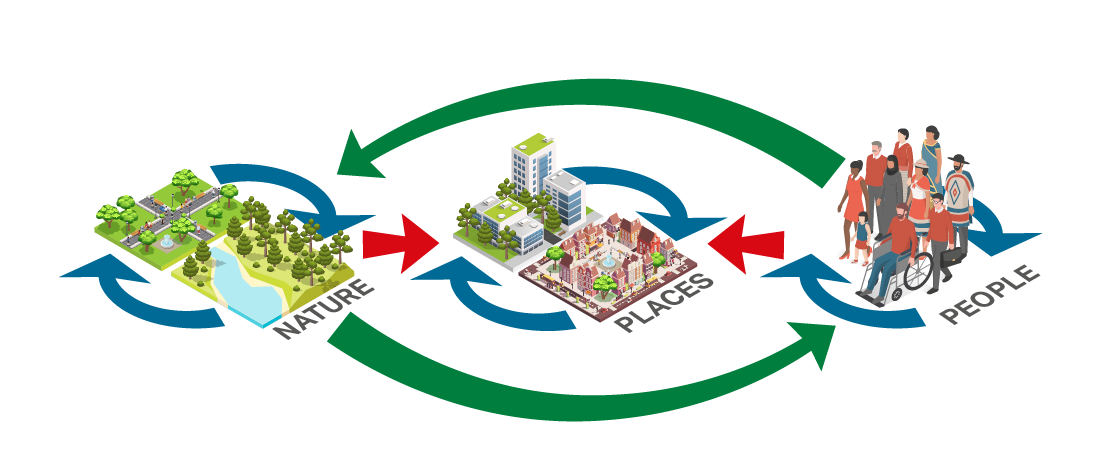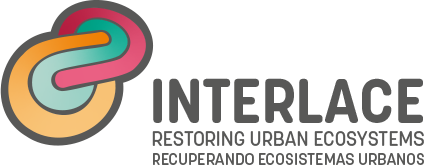
Nature, People and Places
The INTERLACE project supports actions to restore, rehabilitate and (re)connect ecosystems. We understand ecological systems as part of complex, integrated systems in which humans and nature are intrinsically linked. INTERLACE embraces this complexity through its ‘Nature-Places-People’ concept. This approach emphasises not only ecosystem connectivity, but a much broader connectivity of natural and social processes and places.

INTERLACE approach to restore, rehabilitate and connect nature, places and people
Guided by this central concept, the INTERLACE project will foster the deployment of diverse nature based solutions that:
- allow NATURE and biodiversity to thrive through the creation of new green areas and the recovery of degraded ecosystems
- cultivate shared PLACES for dialogue and exchange between urban, peri-urban and rural populations and administrations.
- strengthen connectedness between PEOPLE in urban settings - both to one another and to their natural environment
Agile Co-production process
Creating fit-for-purpose instruments in complex urban contexts is highly challenging and requires effective transdisciplinary approaches and cooperation with stakeholders and beneficiaries. INTERLACE will use an agile co-production process to develop its tools, approaches and guidance and to increase their relevance, legitimacy, and impact. To this end, local knowledge brokers and city partners will jointly oversee the co-production processes in each city and invite further beneficiaries to provide feedback, new knowledge and other perspectives. This approach will also accommodate for new emerging demands to be taken into account during the entire development process of the INTERLACE outputs.
Inclusive participation
Fostering inclusive participation in INTERLACE is essential in capturing the wealth of knowledge, experiences, perceptions and values across the EU and CELAC regions and to generate relevant and equitable project outcomes. The project activities are designed with a sensitivity towards diverse cultural traditions, gender roles, access to power, and societal and political structures. Engaging with vulnerable, underrepresented and marginalised urban populations in addition to other stakeholder groups is also a key focus in the project’s collaboration and co-production processes. Through its inclusive participation, INTERLACE will help to build capacities, support learning and exchange, increase awareness and generate new knowledge on restorative nature-based solutions with the EU and CELAC regions and beyond.
Small and medium-sized cities
Small and medium-sized cities play a decisive role in ensuring widespread action to achieve the global sustainable development goals and thus receive particular focus in INTERLACE. Home to 57% of urban population in the EU and 41% in CELAC region, cities with populations under 300,000 inhabitants can deliver ecologically coherent urban planning at a lower human and financial cost than large metropolises while generating development opportunities in their regions. At the same time, the challenges they face remain under-addressed compared to global metropolises.
INTERLACE´s six city partners are central to the project’s activities. To represent diverse urban ecosystems and governance contexts of small- and medium-sized cities in EU and Latin America they include four cities (Granollers, Envigado, Portoviejo, Chemnitz) and two intermunicipal associations (Metropolia Krakowska, Corredor Biológico Interurbano Río María Aguilar-San José). They represent diverse urban ecosystems and governance contexts of small- and medium-sized cities in EU and Latin America and share the challenge of restoring and preventing further degradation of urban and peri-urban ecosystem while pursuing sustainable development objectives.
Small and medium-sized cities can deliver ecologically coherent urban planning at a lower human and financial cost than large metropolises. Connected to their rural hinterlands or forming part of a wider metropolitan landscape, these cities are uniquely positioned to protect, restore and rehabilitate (peri)urban ecosystems while generating development opportunities in their region. Despite this transformative, high impact potential and their recognized importance for achieving sustainable development objectives small and medium-sized cities and the challenges they face remain under-addressed compared to global metropolises, a key problem that INTERLACE is aiming to address.
INTERLACE will foster mutual learning between city partners through city pairings based on city needs, ambitions, challenges and characteristics as well as regional and global city network accelerators. Learn more about Collaboration between Cities.
